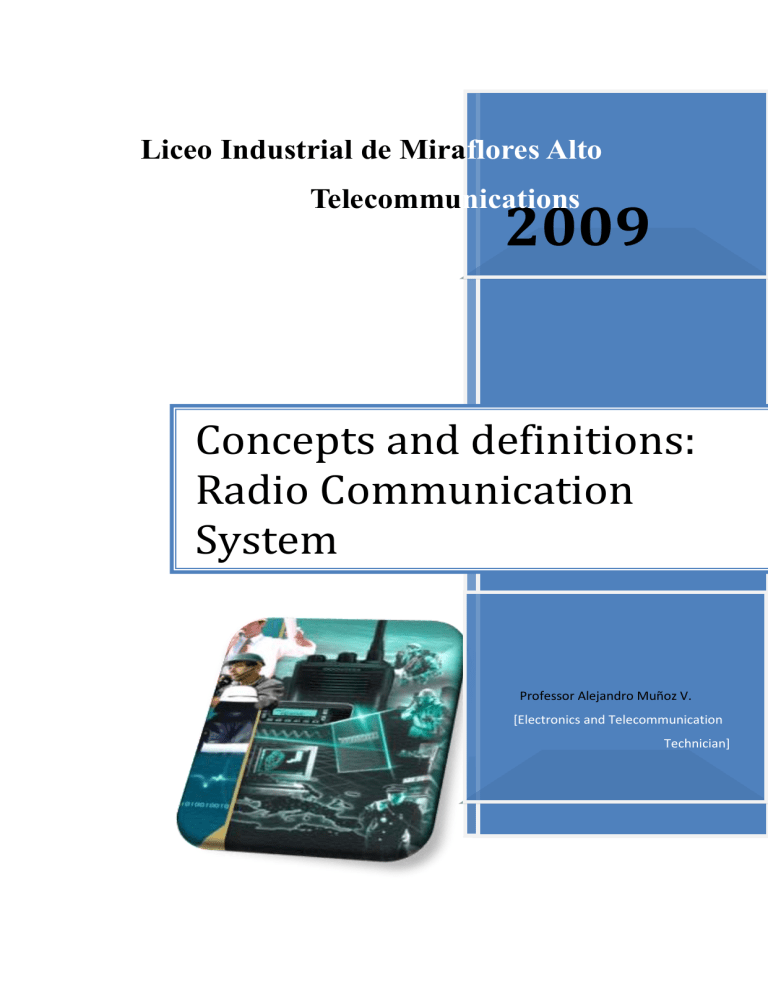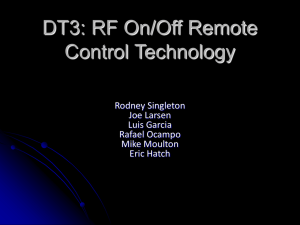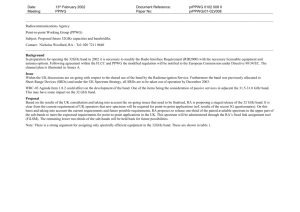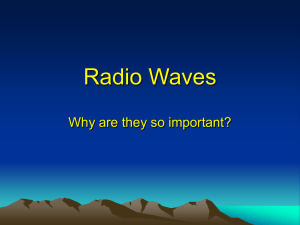Disciplinary text

Liceo Industrial de Mira flores Alto
Telecommu nications
2009
Concepts and definitions:
Radio Communication
System
Professor Alejandro Muñoz V.
[Electronics and Telecommunication
Technician]
CONTENT INDEX
1. Unit 1: Concepts and definitions
I Electrical signals
Continuous signals
Alternate signals
II Digital signals
III Parameters of the alternate sinusoid signal
IV
V
VI
VII
Amplitude (Am) or Peak Value (Pv)
Peak to peak Value (ptpV)
Real Value or RMS (rmsV)
Average value
Period (P)
Frequency (f) or Cycles per Second (cps)
Signal Phase (°) degrees (rad) radians
Wave Length
Measure Units
Radio Frequency bands frequency bands Assignation
Audio Frequency Signals (AF)
Infrasound signals
Audio Signals
Deep or Low Sounds
Average Frequency sounds
High-pitched Sounds
Ultrasound Signals
Pitch Control
Equalizer
VIII Band Width
Telephone band Width
TV Channel band Width
MA radio Band Width
MF Radio Band Width
PRELUDE: CONTEXTUALIZATION
In this introductory work, a review of the basic concepts related to the area of
Electricity will be presented. Within this field, one of the challenges you will meet is the analysis and execution of physics and mathematics formulas that will later be applied in the module of “Installation and maintenance of sound and image equipment”. This list of concepts and their corresponding exemplifications will guide you towards the application of your knowledge in the area of Radio Electric Spectrum, taking into account the following contents as reference to previous knowledge on the area: a) acoustics and electro-acoustic, b) audio sign treatment, c) radio communication, and d) emission and reception radio equipments.
The specific topics with which this work deals with are the electrical signals, the digital signals, the parameters of the alternate sinusoid signal, measure units, radio frequency bands, the frequency bands assignation, the audio frequency signals, and the band width. Some of these topics and their corresponding sets of concepts will be defined and worked out in a more detailed manner than others in which only formulas will be given.
INTRODUCTION
The presentation of concepts of electricity within the field of sound and image equipment aims at reviewing the basis for the later application of the same concepts in the interpretation and practical application of a technical manual.
This work has been divided into eight sections which correspond to the first unit called “Concepts and Definitions: Radio communication system”. Each section has been divided as well into different categories which correspond to the concepts you will need to study.
Introduction to Unit 1
It is widely known that our receptors tune different frequency bands: medium wave, short wave, MF (VHF), etc. These bands correspond to divisions of the radioelectric spectrum which are made up to distribute different services of telecommunications. Each one of these frequency ranges has particular characteristics
which allow different reception possibilities for the technician; this is why it is very important that the technician knows the main characteristics of each one of them.
Before going deeper into some essential definitions, it is important to clarify what is meant by Radio-electric Spectrum. This concept refers to the portion of the electromagnetic spectrum occupied by the radio waves used for telecommunications.
The electro-magnetic spectrum is formed by radio waves: infrared, visible light, ultraviolet light, X-ray, and gamma-ray: all of these correspond to similar energy forms, but they have different frequencies and length waves (as indicated in the following figure).
Frequencies are measured in Hertz (cycles per second): in telecommunications, radio frequencies use the following multiples:
Multiple Abreviation Hertz Also known as:
Kilo Hertz KHz 1.000Hz Kilocycles (Kc/s)
Mega Hertz
Giga Hertz
MHz
GHz
1.000KHz
1.000MHz
Megacycles(Mc/s)
Gigacycles (Gc/s)
The wave length is measured in meters (radio waves are measured in meters, centimeters, and millimeter). The relation between frequency and amplitude is inverse and the relation between both is expressed as it follows:
Frequency in KHz = 300.000
Wave length in meters
KHz
Wave length in meters = 300.000
Frequency in
Unit 1
CONCEPTS AND DEFINITIONS
RADIO COMMUNICATION SYSTEM
I ELECTRICAL SIGNALS
1. Continuous signals
The continuous signal is one that does not change its polarity over time. It can change its magnitude and it can be positive or negative. Some examples are the following: the electrical signal of a car battery terminal (12 volts), watch battery (1.5 volts), and the tele phone line when it’s put down (48 volts.)
2. Alternate signals
The alternate signal is one that changes its polarity over time, alternating between positive and negative values. Some examples are: the voltage of the electric energy net, the signal of the microphone terminals , the signal of the sound system speakers’ terminals, the terminals of a telephone receiver.
(A) Rectangular or pulse wave. (B) Triangular wave. (C) Ramp wave. (D) Sinusoid wave.
II DIGITAL SIGNALS
Digital signals consist of two logical levels: “1” or “0”. These levels are called
BITS and they correspond to a train of pulses of only two voltage levels: a high and a low one. This type of signal can be found in: the communication of two computers, the telephone line when a fax is being sent or received, the connection to internet through a telephone line, etc. Its transmission speed is measured in Bits per second (bps)
III PARAMETERS OF THE ALTERNAL SINUSOID SIGNAL
This signal is called sinusoid signal because it can be mathematically represented through the trigonometric function SINE; the following formula represents its expression: v = Am Sine ( 2 PI f t)
Where: v is the alternate signal
Am is the signal amplitude
PI is the number 3.14 f is the frequency in cycles per second or hertz of the signal t is the time that takes place per signal
a) AMPLITUDE (Am) or Peak Value (Pv)
The amplitude corresponds to the value that the signal has between level cero and its maximum negative or positive value.
Am = Pv b) PEAK TO PEAK VALUE (ptpV)
The peak to peak value is the average between the two peaks of the signal and it corresponds to the value of two times the signal amplitude. ptpV = 2 Am c) REAL VALUE OR RMS (rmsV) rms = Root Mediun Square
The real value or Root Medium Square value corresponds to the real value of the signal, in other words, it corresponds to the value that the continuous signal should have in to produce the same power. rmsV = Am / 2 or rmsV = 0,707 Am
The following formula can be deducted:
Am = 2 Vrms or d) Average value (Av)
Am = 1.41 Vrms
The average value corresponds to the mathematical average of the positive and negative values of the alternate signal. In this case, both semi-cycles are equal and their value is cero.
Av = 0 e) PERIOD (P)
The period corresponds to the time that a signal takes to complete a cycle. It is measured in seconds. A signal cycle corresponds to the fundamental form that repeats itself in time.
P = Period (seg) f) FREQUENCY (f) or CYCLES per SECOND (cps)
The frequency corresponds to the number of cycles per second of the electric signal. It is measured in Hertz and it is inversely proportional to the period: the higher the frequency of the signal, the shorter its period. f = 1 / P (Hertz) or f = 1 /P (cps)
The following formula can be deducted:
P= 1 / f (seg)
This parameter is one of the most important tones because it basically determines the classification of electric signals and communication equipments. g) SIGNAL PHASE (°) degrees (rad) radians
The completion of an alternate sinusoid signal cycle equals a rotation of 360 degrees or 2 PI radians. The following equivalencies can be stated:
Initial 0 °
¼ of a cycle 90 °
Half a cycle 180 °
¾ of a cycle 270 °
1 cycle 360 °
0
PI / 2
PI
3 PI / 2
2 PI rad rad rad rad rad
The phase of an electric signal is a comparative measure of the beginning of its cycle with the beginning of a referential signal cycle. This phase is measured in degrees or radians.
It can be concluded that two signals are “in phase” when the beginning of both signals coincide or when the gap between them is 0 degrees.
A signal has a 90 degrees delay gap when its cycle beginning starts when the referential signal is already ¼ ahead or when it is 90 degrees ahead. h) WAVE LENGTH (Lamda) ( λ)
The wave length corresponds to the distance measured in meters that covers the signal cycle through the transmission media.
The transmission speed through a space is close to the light velocity (c).
Where c = 300.000.000 m/s or c = 300.000 Km/s
It must be taken into account that an electric signal suffers a decrease of its velocity depending on the transmission media: wire, cables, wave guides, aerial space, etc.
Then,
Wave Length = Lamda = c /f (mts)
Where c is the velocity of light in meters f is the frequency of the electric signal transmitted through Hertz.
This parameter of the signal is very important for the calculation of the antenna of communication equipment because it determines its size to achieve the optimal emission or reception of the signal.
MEASURE UNITS IV
1 s
TIME (It is measured with a stopwatch or a watch)
= 1second = 1s
1 ms
1 us
= 1 milli-second
= 1 micro-second
= 0,001 s
= 0,000001 s
1 ns = 1 nano-second = 0,000000001 s
1 um
DISTANCE (it is measured with a vernier caliper, a ruler, tape measure, etc.)
= 1 micron = 0,1 mm = 0,0001 m
1 mm
1 cm
1 m
1 Km
= 1 millimeter
= 1 centimeter
= 1 meter
= 1 Kilometer
= 1 mm
= 10 mm
= 1000 mm
= 1000 m
= 0,001 m
= 0,01 m
= 100 cm
FREQUENCY (It is measured with a frequency counter)
1 Hz
1 KHz
1 MHz
1 GHz
= 1 Hertz
= 1 Kilo-Hertz
= 1 Mega-Hertz
= 1 Giga-Hertz
1000000000 cps
1 THz = 1 Tera-Hertz
= 1 cps
= 1000 Hz
= 1000000 Hz
= 1000 MHz
= 1000 GHz
= 1000000 KHz
= 1000000 GHz
=
1 uV
VOLT (It is measured with a voltage calibrator which are part of multi-testers)
= 1 micro-volts = 0,000001 volts
1 mV
1 V
1 KV
= 1 milli-volts
= 1 Volts
= 1 Kilo-Volts
= 0,001 volts
= 1000 mV
= 1000 Volts
= 1000000 uV
ELECTRIC CURRENT (it is measured with an ampere-hour meter or milliampere-hour meter; they are part of multi-testers)
1 nA
1 mA
= 1 Nano-Ampere
= 1 Mili-Ampere
= 0,000000001 A
= 0,001 A
1 A
1 KA
1 M
= 1 Ampere
= 1 Kilo-Ampere
= 1000 mA
= 1000 A
1
1 K
RESISTOR (it is measured with an ohmmeter which is part of the multi-tester)
= 1 Ohms
= 1 Kilo-Ohms = 1000 Ohms
= 1 Mega-Ohms = 1000000 Ohms
V RADIO FREQUENCY BANDS
The main group of Radio frequency Bands and their lengths are:
VLF = very Low Frequencies
LF = Low Frequencies
MF = Average Frequencies
HF = High Frequencies
3 Hz / 30 KHz / 100 Km / 10 Km
30 KHz / 300 KHz/ 10 Km / 1 Km
300 KHz / 3 MHz / 1 Km / 100 m
3 MHz / 30 MHz / 100 m / 10 m
VI
VHF = Very High Frequencies 30 MHz / 300 MHz / 10 m / 1 m
UHF = Ultra High Frequencies 300 MHz / 3.000 / MHZ 1 m / 0, 1 m
SHF = Super High Frequencies 3 GHz/ 30 GHz / 0, 1 m / 0, 01 m
EHF = Extra High Frequencies 30 GHz / 300 GHz / 10 mm / 1 mm
Light Frequency
Infra Red radiation
300 GHz inferior limit 1 mm
300 GHz/ 3.000 GHz / 1 mm / 10 um
FREQUENCY BANDS ASSIGNATION
The F.C.C. (Federal communication committee) has assigned the following frequency
Bands for telecommunications:
30 KHz communication)
535 KHz (It includes maritime and navigation
535 KHz 1605 KHz (MA (modulated amplitude) broadcasting Band)
1605 KHz 30 MHz (MA and short wave (SW) radio ham and Broadcasting)
30 MHz
50 MHz
54 MHz
VHF)
72 MHZ
50 MHz
54 MHz
72 MHz
76 MHz
(Fixed and mobile official stations)
(6 meters Radio ham Band)
(Television channels CH2-CH3-CH4 band I of
(Official and non-official services (lighthouse radio))
76 MHz
88 MHz
108 MHz
122 MHz
174 MHz
III of VHF)
216 MHz
470 MHz
88 MHz (Television channels CH5, CH6 Band I of VHF)
108 MHz (MF transmitting or radiating Band II of VHF)
122 MHz
174 MHz
216 MHz
(Aeronautic navigation)
(Radio ham Band)
(TV CHs CH7-CH8-CH9-CH10-CH11-CH12-CH13 Band
470 MHz
890 MHz
(Radio ham stations, civil aeronautics)
(Cable TV transmitter UHF CH14 to CH83)
890 MHz 3 GHz (Radar, microwaves, booster stations, cell phones)
3 GHz
30 GHz
30 GHz
300 GHz
(Satellites and booster stations)
(Experiments)
VII AUDIO FREQUENCY SIGNALS (AF)
Audio frequency signals are all electric signals which frequency flows between 0
Hertz and 200 Kilo Hertz approximately. Their special feature is that they do not radiate like electro-magnetic waves, but rather like variations of the shape of sound waves through the air. They have an unlimited reach. Equipment that are able to produce these signals are called Audio frequency signal generator.
These audio frequency signals can be divided into:
INFRASOUND SIGNALS
These signals are the ones which frequency flows between 0 Hertz and 20 Hertz. They can’t be perceived by humans.
AUDIO SIGNALS
These signals are the ones which frequency flows between 20 Hertz and 20 Kilo-Hertz.
They can be perceived by humans and reproduced via sound equipments.
DEEP OR LOW SOUNDS
These are electric signals that produce low-pitched sounds when converted into sound.
Their frequency flows between 20 to 400 Hertz. Among their applications some examples are: low speakers, the tuba, and the trombone.
AVERAGE FREQUENCY SOUNDS
These are electric signals that produce average frequency sounds when converted into audible sounds. They produce sounds like the human voice when amplified through a microphone.
HIGH-PITCHED SOUNDS
These are electric signals that reproduce high pitches when reproduced through a speaker called “tweter”. These sounds are generated by clarinets and in general by cord instruments.
ULTRASOUND SIGNALS
These signals are average frequencies that flow between 20 kilo-Hertz and 200 Kilohertz. They ca n’t be perceived by humans. Among their electronic applications some examples are: TV remote controls, canine whistles, and remote controls.
PITCH CONTROL
These are circuits which allow increasing or decreasing the level or amplitude of the audio signals within a specific range of frequencies. Some examples are: low pitch controls, average frequency pitch control, and high pitch controls.
EQUALIZER
An equalizer is an electronic circuit which i sable to control pitches of audio signals separating them into five or more Bands and augmenting or decreasing the level of the signals that are closet o the central frequencies of those bands (300Hz, 1Kz, 2KHz,
5KHz, 10KHz, etc)
VIII BAND WIDTH
The Band width corresponds to the difference between the highest frequency (f2) and the lowest frequency allowed for a cannel or communication media.
TELEPHONE BAND WIDTH
BW = f2 - f1 (Hertz) = 3400 Hz – 300 Hz = 3100 Hz
TV CHANNEL BAND WIDTH
BW = f2 – f1 (Hertz) = 6 MHz – 0 MHz = 6 MHz
MA RADIO BAND WIDTH
BW = 10 KHz
MF RADIO BAND WIDTH
BW = 20 KHz






